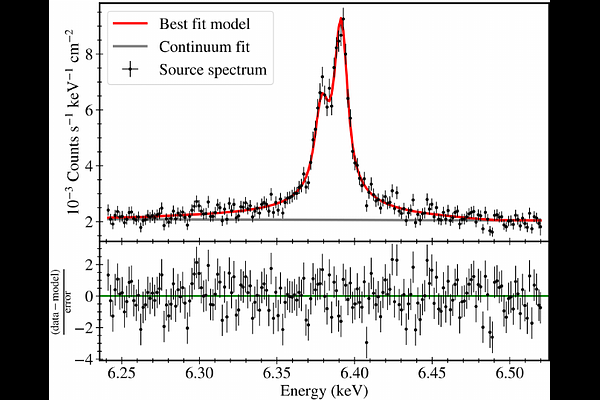XRISM analysis of the complex Fe K$α$ line in Centaurus A

XRISM analysis of the complex Fe K$α$ line in Centaurus A
David Bogensberger, Yuya Nakatani, Tahir Yaqoob, Yoshihiro Ueda, Richard Mushotzky, Jon M. Miller, Luigi C. Gallo, Yasushi Fukazawa, Taishu Kayanoki, Makoto Tashiro, Hirofumi Noda, Toshiya Iwata, Kouichi Hagino, Misaki Mizumoto, Misaki Urata, Frederick S. Porter, Michael Loewenstein
AbstractWe analyze the high-resolution XRISM/Resolve spectrum of the Fe K$\alpha$ emission line of the nearest active galactic nucleus, in Centaurus A. The line features two narrow and resolved peaks of Fe K$\alpha_1$, and Fe K$\alpha_2$ with a FWHM of $(4.8\pm0.2)\times10^2$ km/s each. A broad line with a FWHM of $(4.3\pm0.3)\times10^3$ km/s, and with a flux similar to the two narrow line cores, is also required. This broad component is not observed in the optical or IR spectra of Cen A. The line shape requires the existence of an emission region that extends from $\sim10^{-3}$ pc to $\sim10^1$ pc. Assuming that the emissivity follows a radial power-law profile of $r^{-q}$, we find $q\approx2$. This may indicate an extended corona, an emitting region that bends towards the corona, or a non-uniform density. When assuming $q=3$, the line shape can only be reproduced by including three emitting components in the model. The measured best-fit inclination is $24^{+13}_{-7}$ degrees, but higher inclinations are only slightly disfavored. A single blurred MYTorusL line profile can describe the line shape, but requires a large relative normalization. This could be due to past variability, modified abundances, or differing geometries. The line shape can be reproduced from the radii measured by reverberation mapping, but only if an additional extended emitting region at small radii is included.